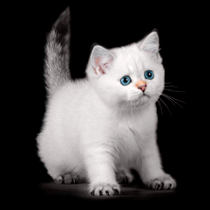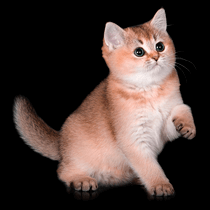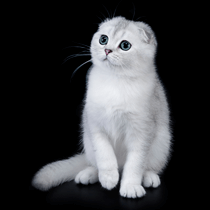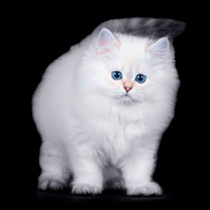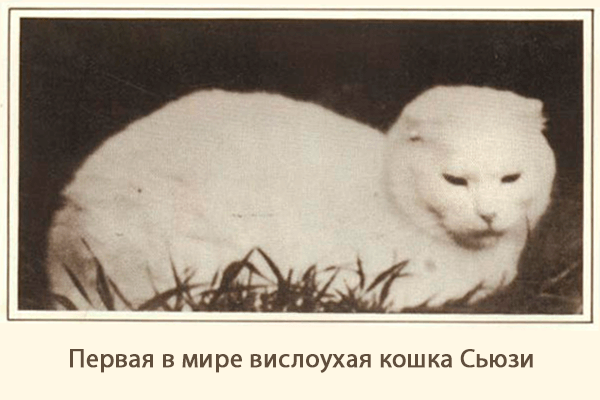 A plush coat, big round eyes, a sweet face, reminiscent of either a teddy bear or an owlet and invariably evoking affection – this is a Scottish Fold or Scottish Straight cat. In China and the Far East, fold cats have been encountered for a long time and were originally called Chinese cats. Back in the 18th century, one of the English magazines wrote about the amazing domestic fold cats living in China. Nevertheless, the creator of the Scottish breed is William Ross, who in 1961 saw and bought from a farm owner in Scotland a fold kitten (white kitten) – one of two kittens born to a Scottish cat with fold ears named Susie. Susie’s fold ears are the result of a natural genetic mutation that causes the cartilage tissue in the body to become so weak that it is unable to keep the ears upright. With the help of geneticists, a Scottish cat was bred on the basis of the British and American shorthair breeds. After all, even Susie, the ancestor of Scottish cats, had some of the kittens with long-haired, and only through selection was it possible to create a stable short-haired look. When working on the breed, the Americans came to the conclusion that when crossing two Scottish long-haired cats, the offspring’s coat turns out to be too thick and long, similar to Persian hair. The optimal was the crossing of short-haired individuals with long-haired ancestors with Scottish long-haired cats, which gives offspring with gorgeous fur.
A plush coat, big round eyes, a sweet face, reminiscent of either a teddy bear or an owlet and invariably evoking affection – this is a Scottish Fold or Scottish Straight cat. In China and the Far East, fold cats have been encountered for a long time and were originally called Chinese cats. Back in the 18th century, one of the English magazines wrote about the amazing domestic fold cats living in China. Nevertheless, the creator of the Scottish breed is William Ross, who in 1961 saw and bought from a farm owner in Scotland a fold kitten (white kitten) – one of two kittens born to a Scottish cat with fold ears named Susie. Susie’s fold ears are the result of a natural genetic mutation that causes the cartilage tissue in the body to become so weak that it is unable to keep the ears upright. With the help of geneticists, a Scottish cat was bred on the basis of the British and American shorthair breeds. After all, even Susie, the ancestor of Scottish cats, had some of the kittens with long-haired, and only through selection was it possible to create a stable short-haired look. When working on the breed, the Americans came to the conclusion that when crossing two Scottish long-haired cats, the offspring’s coat turns out to be too thick and long, similar to Persian hair. The optimal was the crossing of short-haired individuals with long-haired ancestors with Scottish long-haired cats, which gives offspring with gorgeous fur.
When breeding a Scottish breed, breeders faced the fact that in order to obtain offspring of Scottish Fold cats – Scottish Fold can only be knitted with Scottish Straight (with ordinary ears). It turned out that when mating Scottish Fold cats with Scottish Fold, as a result of genetic changes in the body, cartilage tissue can be affected, the skeleton is deformed, defects of the musculoskeletal system develop (short, thick tail, crooked paws, accrete vertebrae, thickened joints) , up to the complete immobility of the cat. The lop-ear (fold) gene is dominant (predominant), but kittens with fold and straight ears can be equally present in the same litter.
On a kitten’s birthday, it is impossible to determine which of them will be a fold-eared kitten – a Scottish fold, and which a straight-eared kitten – a Scottish straight. Only by 3-4 weeks of age in some kittens the ears begin to bend forward and downward lop, and by 3 months they finally lop.
The first Scottish cat breed standard was registered in 1978 by the Cat Fanciers’ Association (CFA) – one of the oldest and largest felinological organizations located in the United States. Since then, it has changed several times.
Some felinological organizations consider Scottish fold and associated genetic mutations a disadvantage, so the breed is not recognized by all international associations of breeders, for example, the FIFE (International European Cat Breeding Federation) did not recognize it, but despite this, Scottish cats spread in Europe. So Scottish Fold kittens are very popular in Australia, America and Russia.

